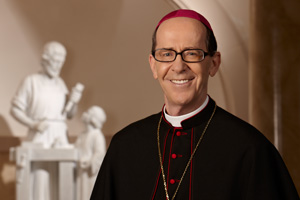
[dropcap]D[/dropcap]oubt clouded the hearts of fourth century Christians. Confusion was sown by a priest named Arius. Dark storms of skepticism swept across large swaths of the Church, which had taken root on all sides of the Mediterranean. Even priests and bishops (some historians say the majority of them) were led astray by Arius’ alluring preaching, his popular poems and catchy songs that spread false notions about the identity of Jesus. In less than a century, Arius’ ideas (now known as Arianism) became prominent all across the Roman Empire. One 20th century scholar, Fr. Christopher Rengers, OFM Cap., described the fallout of the Arian heresy in the following way, “A great controversy that involved emperors, popes and bishops, that stirred up intrigue and bloodshed, that shook Christianity to its depths, centered on one simple, sure answer in the Catechism. The answer goes very simply: ‘The chief teaching of the Catholic Church about Jesus Christ is that He is God made man.’”
Arius taught that Jesus is unequal to the Father, that “there was a time when he was not,” i.e. that Jesus had a beginning, i.e. was not eternal. Arius did not believe what we profess in the Creed each Sunday, namely that Jesus is “consubstantial with the Father.” Though conceiving of Jesus as a mere creature seemed to make Jesus more palatable, Arius’ innovation excoriated Christianity of its center — that God became man to save and share His divine life with us. Thus in the battle with the confusion of Arianism, everything was at stake.

To confront this colossal controversy, to overcome the doubts sown by Arius and his followers, and to begin to restore clarity and peace to the hearts of all believers, the Lord raised up several persuasive teachers of the true faith; most notable among these were Saint Athanasius of Alexandria in Egypt, and St. Cyril of Jerusalem. Of these two bishops known today as doctors of the Church, Athanasius earned the title “Father of Orthodoxy” and Cyril the title “Doctor of Catechesis.” Both men suffered greatly for their fidelity: Athanasius was forced into exile on five separate occasions during his ministry as Bishop of Alexandria; and Cyril was exiled from Jerusalem three times; 16 of his 35 years as a bishop were in forced exile.
One writer compared these two holy men in the following way: “The life of St. Cyril of Jerusalem may be described as a kind of abridged edition of that of St. Athanasius.” While Athanasius exercised greater influence among his brother bishops in defending the true identity of Jesus and expounding a solid theological foundation for this teaching, Cyril developed a systematic catechesis to explain the pivotal truths of our faith in a way that was readily accessible to the ordinary faithful.
Cyril’s Catechesis for catechumens and the newly baptized remains today a primary source for the Rite of Christian Initiation of Adults, popularly known as the RCIA, which was re-established at the Second Vatican Council, half a century ago, and which remains the ordinary way for bringing adults into the Church.
St. Athanasius and St Cyril embody in an exceptional way two of the Spiritual Works of Mercy, namely to counsel the doubtful and to instruct the ignorant. Both of these spiritual works are as badly needed today as they were in the fourth century. That is why I am so grateful to the catechists in the RCIA and other programs of religious formation who assist me in handing on the teachings of Jesus and His Church. As we do so, we mercifully help to heal a culture of skepticism that troubles many of our contemporaries with doubts about the existence of God and therefore about the existence of objective truth. Many also are skeptical about our ability to know what is right and thus to avoid what is wrong. Some no longer believe that virtue is even possible and thus that holiness is within their reach.
In the face of this skeptical culture, God, who never leaves His flock untended, is raising up faithful witnesses among all ranks of the faithful, clergy and laity alike, filling them with joyful confidence in the truths of our Catholic faith. They have no doubt that Our Creator made each of us with an intellect that reaches out for the truth and that He gives us the grace needed to grasp the truth and put it into practice.
In this Lenten season of 2016 when the RCIA reaches its climax and many catechumens will be baptized at the Easter Vigil, just as they were in the days of St. Cyril of Jerusalem, let us welcome with joy our new brothers and sisters in Christ. Let us also ask St. Athanasius and St. Cyril to pray for us that we, too, may be merciful bearers of truth.







